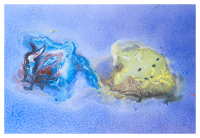Conveners
Parallel II: B2 Light Quarks
- Jose Luis Goity (Hampton University/Jefferson Lab)
Nilmani Mathur
(Tata Institute of Fundamental Research)
08/09/2014, 16:30
Section B: Light Quarks
Baryon spectroscopy has played a crucial role in formulating the theory of strong interaction, particularly in the low-energy regime. In this talk I will review the recent progress in the excited state spectroscopy of baryons using lattice QCD and the implications of these results. In particular, excited state spectroscopy of heavy baryons will be emphasized where the experimental efforts are...
Prof.
Kalman Szabo
(Forschungszentrum Juelich)
08/09/2014, 17:00
Section B: Light Quarks
We compute the neutron-proton mass splitting and show that it is greater than zero by five standard deviations. Furthermore, splittings in the Sigma, Xi, D and Xi_cc isospin multiplets are determined providing also predictions. We perform lattice Quantum-Chromodynamics plus Quantum-Electrodynamics computations with four, non-degenerate Wilson fermion flavors. Four lattice spacings and pion...
Guido Martinelli
(Scuola Int. Superiore di Studi Avanzati (IT))
08/09/2014, 17:30
Section B: Light Quarks
A new strategy to compute electromagnetic corrections to weak transitions is presented. The specific case of $\Gamma(\pi^H+ \to l^H+ \nu + \gamma)$ is discussed in detail, and possible extensions of the method will also be discussed.
Andria Agadjanov
(University of Bonn)
08/09/2014, 18:00
Section B: Light Quarks
Lattice quantum chromodynamics (LQCD) provides an ab initio way to study the non-perturbative aspects of strong interaction. In recent years, it plays a more significant role in experimental physics.
The studies of the different electromagnetic and weak processes on the lattice are of particular interest. Some of the important processes proceed through the resonances. However, the...
